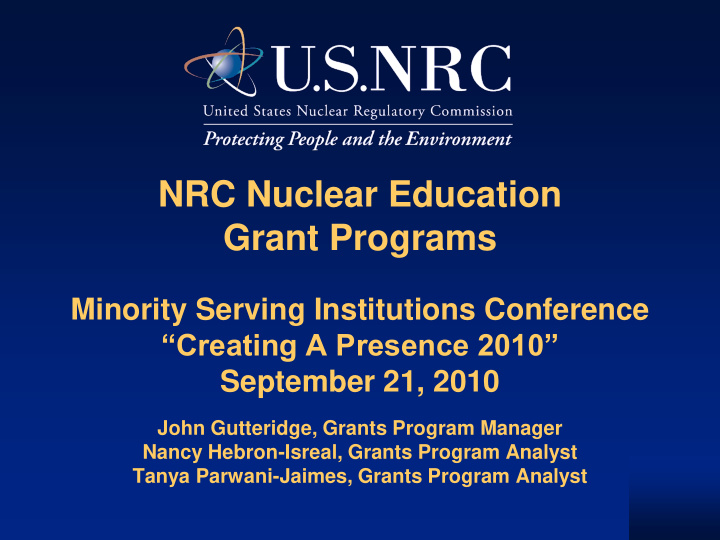



NRC Nuclear Education Grant Programs Minority Serving Institutions Conference “Creating A Presence 2010” September 21, 2010 John Gutteridge, Grants Program Manager Nancy Hebron-Isreal, Grants Program Analyst Tanya Parwani-Jaimes, Grants Program Analyst
Program Overview • NRC Nuclear Education Grant Programs ($20M) - $5M for Curricula Development - $15M for Scholarships/Fellowships, Faculty Development, and Trade Schools/ Community Colleges - Focus is on Nuclear Engineering, Health Physics, and Radiochemistry 2
Program Authorization – ($5M) Curriculum Development • Energy Policy Act of 2005 “…to support courses, studies, training, curricula, and disciplines pertaining to nuclear safety, nuclear security, nuclear environmental protection, and other fields that the Commission determines to be critical to NRC’s regulatory mission.” 3
Program Authorization - $15M (scholarships, fellowships, faculty development, trades/community colleges) • Yearly Congressional Language (2008 on) • “ Funding ….includes $15,000,000 to support education in nuclear science, engineering, and related trades to develop a workforce capable of the design, construction, operation, and regulation of nuclear facilities and the safe handling of nuclear materials.” • Benefit the nuclear sector broadly, not primarily NRC 4
Grant Specifics ($20M) • Scholarships – 2 years, $10,000 per student per year, awarded to institution ($200,000) • Fellowships – 4 years, $50,000 per student per year, awarded to institution ($400,000) • Faculty Development – 3 years, $150,000 per year plus institution match ($450,000 + $150,000) • Trade schools/community colleges – 1 year, $10,000 per student ($150,000) • Curriculum development - ~ $200,000 over 2 years 5
NRC Service Agreement • Each scholarship and fellowship recipient must serve six (6) months in nuclear-related employment for each year or partial year of support • Failure to comply, absent a waiver, will trigger repayment from the recipient 6
FY 2011 Funding Opportunity Announcements (FOAs) • FOAs for Scholars, Fellows, Trades/CCs, and Faculty Development issued in June 2010 • Applications CLOSED August 27, 2010 • Awards planned for February/March 2011 • Curriculum Development FOA issued in June 2010 • Letters of Intent due July 9, 2010 • Applications due November 1, 2010* (*NEW DUE DATE!) • Awards planned for March 2011 7
FY 2011 Selection Criteria for Curriculum Development Grants • #1: Potential for Supporting or Advancing the Nuclear Safety, Security, or Environmental Protection Educational Infrastructure, and other fields critical to NRC’s regulatory mission (30 points) • #2: Proposed Approach and Collaborative Linkages (20 points) • #3: Institutional Capability and Capacity Building (20 points) • #4: Key Personnel (20 points) • #5: Budget and Cost Effectiveness (10 points) 8
Performance Metrics Development • The Office of Management and Budget (OMB) requested performance metrics be developed • NRC, in a February 2010 report to OMB, using the Academic Competitiveness Council’s guidelines suggested by OMB, developed metrics for NRC education grants • Grantees must address these metrics in their 6-month performance progress reports 9
Performance Metrics • Undergraduate (scholarship): (synopsis) - Number and percentage of students who complete a STEM major or course of study - Number and percentage of STEM graduates who stay in STEM-related graduate program - Number and percentage of STEM graduates who take a STEM job - Number of students who engage in research experiences in an academic, government, or nonprofit industry 10
Performance Metrics – Con’t . • Graduate (fellowship): (synopsis) - The number and percentage of graduate and postdoctoral fellowships who complete a STEM program - The number and percentage of program completers who are employed in a STEM field - The number and percentage of students who participate in scientific or research experiences in industry, government, or non-profit sector (includes NRC internships) - The number and percentage of students who present research findings at scientific meetings 11
Performance Metrics – Con’t . • Faculty Development: - Number of new faculty hired and currently eligible faculty supported in NRC-designated STEM areas • Curriculum Development: - Overall number of new courses developed in NRC-designated STEM areas - Number of students enrolled in STEM courses - Number of those enrolled students retained in STEM major 12
Significant Developments: 2007-2010 • Nationwide: - Have awarded 313 grants totaling $65M to 108 institutions in 33 states, DC, and Puerto Rico (47 grants to MSIs) - Support over 500 students annually 13
33 States, DC and Puerto Rico Have Received Grants D.C. and R.I Puerto Rico 14
Funding by Year/Grant Type 8 7 Curriculum Devolpment Dollars in Millions 6 Scholarships 5 4 Fellowships 3 Faculty Dev. 2 Trades/CC 1 0 FY 2007 FY 2008 FY 2009 FY 2010 15
What’s Working • Student population growing • New university nuclear programs beginning • Government grant funds leveraged • Partnering occurring • Increased interest of trade schools and community colleges 16
Observations • Applications far exceed available funds • Success in nuclear education and training will, for the foreseeable future, depend upon continued government support • Currently, the greatest near-term workforce needs are in the trade and craft areas • Outreach to pre-college students is essential to enable students to make informed decisions about pursuing the study of nuclear technology 17
Hurdles • Ability to better assess the workforce in terms of personnel and physical infrastructure needs • Limited scope/flexibility of current NRC program • Annual funding uncertainty • Coordination among universities to avoid duplication of effort • Outreach 18
Summary • The NRC grant program has: - Fostered excellent working relationships with educational institutions - Assisted in the development of a well-trained and needed workforce critical to the continued safe operation of nuclear facilities - Developed, and is beginning to collect, metrics useful to measuring the success of the program - Provided assistance to institutions less familiar with NRC grant activities and processes 19
Contacts – Nuclear Education Grants Team, HR • John Gutteridge - john.gutteridge@nrc.gov • Nancy Hebron-Isreal - nancy.hebron-isreal@nrc.gov • Randi Neff* (*currently on rotation to another NRC program office) - randi.neff@nrc.gov • Tanya Parwani-Jaimes - tanya.parwani-jaimes@nrc.gov • Mike Atsalinos - mike.atsalinos@nrc.gov 20
Recommend
More recommend